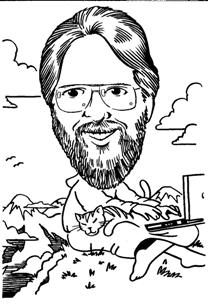Tax Guru-Ker$tetter Letter
Sunday, May 30, 2004
IRS Audit Changes
Except for a few short interruptions, I was able to see and hear most of the IRS webcast a few weeks ago on the changes to their audit procedures. While I had the show on one of my three computer monitors, I typed up a few notes on another; but have been too busy to flesh them out enough to make any sense to anyone else but myself.
There weren't as many changes announced as I had expected, but I did want to mention the following quick observations, which by no means include everything covered during the broadcast. The entire program has been posted to the archives and is available for viewing at everyone's convenience.
They are trying to have a more professional relationship with their "customers" (taxpayers and their representatives). This will include presenting an Engagement Agreement between the auditor and the rep to lay out the audit plan, along with an expected conclusion date. They had to admit that the reality of knowing with any certainty how long an audit would take up front is pretty close to unknowable. They admitted that their most lucrative findings (aka big bucks for Uncle Sam) come about from issues that are accidentally discovered during the audit and not from the items spelled out in the initial audit request.
Approximately mid-way through the audit, the auditor is supposed to assess things and decide whether to expand or drop the audit.
Audit manual with new procedures will be available online to practitioners.
High priority audits include tax avoidance promoters and their clients.
High income = high risk. $250,000 and up of income.
They made the same bogus and completely unsubstantiated claim that two thirds of the tax gap is from unreported self employment income. As I've mentioned several times before, I have attempted to track down the source of these statistics from IRS big-wigs and they admitted to me that they are using WAGs (wild ass guesses) in a blatant attempt to scare up more budget money from our rulers in Congress. Since the real tax gap numbers are by definition impossible to ascertain, their fabricated figures are technically just as good as any.
They have a top secret scoring model with four filters to assess risk, including:
High income, non-filers.
UI (Unreported Income) and - DIF (Differential Index Function) filter. Unreported income. Finds a lot of businesses and high income persons.
Many layers of entities. This has long created suspicion with IRS. They often suspect that this approach is just used to cheat on taxes. However, the truth is a bit different. While using several layers of partnerships, trusts, LLCs and corporations can help reduce taxes, I find it even more useful for preserving privacy and protecting against frivolous lawsuits. The tougher you make it for ambulance chasers to sue you, by operating behind layer upon layer of entities, the less likely they are to take on a contingent extortion case.
About a week after this IRS web seminar, I spent most of the day with an IRS auditor in my office and we had a chance to discuss the subject of these new procedures. She agreed with me that the agreed commitment date they come up with in their engagement agreement is, by necessity, pulled out of the air because nobody has any idea what new issues they may stumble across during the examination.
You Get What You Pay For
Although I have worked with dozens of different IRS agents over the past eleven years since relocating to the Ozarks, this was my first case with this particular woman. She asked me an interesting question. How would I compare the quality of the IRS agents I have worked with in this part of the country with those I had worked with back in the San Francisco Bay Area? Anyone who knows me knows that kissing butt, especially IRS fanny, is not part of my MO. However, in an honest reflection of my 29 years working with IRS employees, I realized that there has been a stark difference in their quality between here and back on the Left Coast; and I know exactly why.
One of the big problems IRS has when recruiting new employees is their pay rates. They are pretty much the same across the country. I can still recall when I was getting ready to graduate with my Bachelors degree in Accounting in 1977 and checking the employment opportunities. There were three main categories of prospective employers; Big Eight CPA firms, corporations, and the government. I can remember the IRS recruitment forms, where they laid out all of the criteria they desired. They wanted the best of everything. However, when it came to the salary, they were offering about one third of the starting pay for corporate accountants and a bit less than the Big 8 firms.
To put the CPA firms' pay scales into perspective, they were able to offer very low starting salaries because, in California, prospective CPAs were required to have at least two years experience as employees with a CPA firm. Anyone who aspired to becoming a CPA had to be willing to work for very low pay in order to obtain the appropriate on the job work experience. My starting pay, with the small CPA firm I worked for in Hayward after graduating, worked out to five dollars per hour.
That salary disparity persists to this day. In the Bay Area, IRS can still only pay a fraction of what other employers can. In lower cost parts of the country, such as here in the Ozarks, the IRS salaries are pretty much the same as in the Bay Area. However, they are much more attractive and in line with the pay rates being offered by other kinds of employers. It doesn't take a NASA scientist to see how IRS would be much more able to attract a much higher caliber of employee here than out on the Left Coast. The effects of this have been very obvious.






















